Refraction of Light
Summary
Refraction of light is observed in water and through a prism. Polarizing filters amaze students, as they seem to make light appear and disappear. Finally, students use calcite to polarize light and create double images.
Materials
- Constructing a Polarized Filter Viewer PDF
cardboard polarized filter viewer, one per group, can be constructed by following directions on pdf - 6" x 10" piece of cardboard from a box, 3 5/8 " x 6 1/2" envelope, 2 thin cardboard pieces 1/4" x 4", masking tape - Student Answer Sheet
- Diffraction glasses: stevespanglerscience.com #WRBG 150, $19.99 for 15 pair (called Fireworks Rainbow Glasses on the website)
- Prisms, enasco.com #SB14089M, $4.90
- flashlights, at least one per group
- polarizing filters, two per group: teachersource.com, #PF-3A, $3.75 each
- small mica tiles, may be found in art/craft stores, amazon.com $4.55 for 1.6oz package by US Art Quest, if tiles are too thick they can be separated into thinner sheets by pulling it back with your fingernail
- plastic petri dish or any clear, flat piece of plastic, one per group
- optical calcite crystal, wardsci.com, 49V1600, single piece $4.95
- beaker or clear, plastic cup, one per group
Alternative to purchasing polarizing filters: Polarized sunglass lenses are polarizing filters. You can remove the lenses from an old pair of sunglasses and usually see all the same effects.
Background for Teachers
Attachments
The sun produces all forms of electromagnetic radiation. Visible light is one of these forms. Visible light can be separated into a spectrum of seven colors which all have different wavelengths. The colors are red, orange, yellow, green, blue, indigo, and violet. Red has the longest wavelength (lowest energy) and violet has the shortest wavelength (highest energy). When all 7 colors are seen together, they form white light.
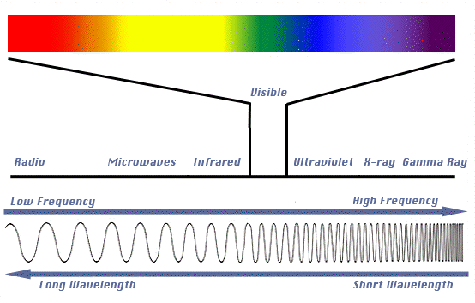
Why do we see an object as red? When visible light hits a red object, all the colors of the spectrum are absorbed except the wavelength of red. It is reflected back to our eyes and we see the object as red. Objects that look white are reflecting back all 7 colors and objects that look black are absorbing all 7 colors.
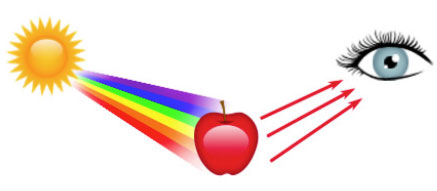
When light exists in a single medium it moves in a straight line and at a constant speed. Refraction or bending of light occurs when light moves from one medium to another. For example, when light moves from air to water it slows down because water is denser than air. The same occurs when light travels through a prism. When light slows down it refracts or bends. If you place a pencil in a glass of water you can easily observe the refraction of light. The pencil appears broken at the air/water interface because the light refracts at the interface.
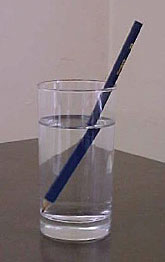
In a prism, the refraction of light is observed because the white light going into the prism splits into its 7 wavelengths of colors when it exits the prism. Shorter wavelength colors, like blue and violet, are bent more than longer wavelengths, like red, so the colors of light always separate into the same pattern.

Light waves emitted from a light source vibrate in all directions. This is referred to as unpolarized light. Normally in unpolarized light, about half the waves are emitted vertically and half horizontally. Light waves in which vibrations occur in a single plane, vertical or horizontal, are referred to as polarized light.
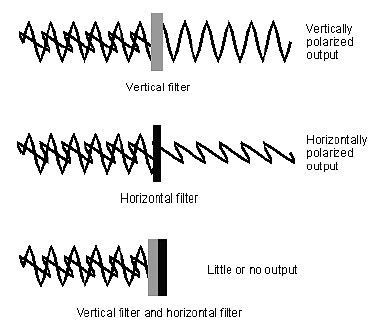
Polarizing filters allow light vibrating in only one plane to pass through the filter. The filter consists of a set of microscopic gates that accept light waves that are either vibrating up and down or side to side. Think of the filter as a picket fence and the only light that will move through the fence must be vibrating in a line that can fit through the spaces of the fence. When light travels through a polarizing filter it has one half the intensity and one half the waves because half of the waves are blocked by the filter. If light passes first through a filter that selects for vertical waves and then through a filter that selects for horizontal waves, no light will be seen coming through the second filter. These filters are referred to as being 'crossed'.
Placing transparent materials, such as plastic or mica, between a set of crossed polarized filters allows the viewer to see certain colors of the spectrum. The first polarizing filter only lets light through that is travelling in a certain direction. The transparent material bends that light, changing the directions of the various light components. As this twisted light travels through the second polarizing filter, only the color that twisted in the same orientation as the second filter will make it through to your eye.
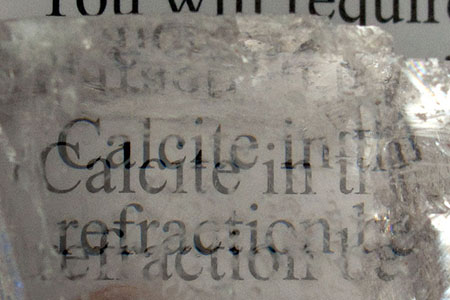
When light passes through calcite, a mineral, the light waves become polarized. One half of the waves become polarized horizontally and one half vertically. This causes a double image to be seen when an image is viewed through a piece of calcite. If a polarizing filter is rotated over the calcite image, the viewer first sees one of the polarized images and then the other polarized image as the filter selects for the horizontal or vertical image.
Polarizing filters are used for many different purposes. Light reflecting off horizontal surfaces like the road, water or snow is horizontally polarized. These horizontal waves cause glare. Polarized sunglasses are oriented vertically and filter out this horizontal glare. Polarizing lenses for cameras fulfill this same purpose. 3D glasses have each lens composed of the different polarizing filters. As each filter allows only that light, which is similarly polarized, and blocks the light polarized in the opposite direction, each eye sees a different image. These two images cause the illusion of 3D.
Intended Learning Outcomes
1a. Observe simple objects, patterns, and events, and report their observations.
1d. Compare things, processes, and events.
1f. Plan and conduct simple experiments.
3a. Know and explain science information specified for the grade level.
4b. Describe or explain observations carefully and report with pictures,
sentences, and models.
4c. Use scientific language in oral and written communication.
5a. Cite examples of how science affects life.
Instructional Procedures
Attachments
Pre-lab discussion: Ask students what types of energy they think we receive from the sun. Explain that it is more than just visible light and heat. Go over the electromagnetic spectrum and other information listed in the background information section of the lab. Demonstrating the filters to the students as you are discussing how filters work keeps them interested in the discussion.
Instructional Procedure: Small groups or set up as stations for rotating groups through the activities
Activity 1: Diffraction glasses and prisms
- Have students use diffraction glasses to observe the ceiling lights, the light from windows, and a lit lamp. Students should recite the colors of the visible spectrum in order from red to violet.
- Hold a prism about 1 foot from a white board. Shine a flashlight into the prism from a distance of about 1 foot. Rotate the prism until you see the spectrum on the whiteboard. Again, note the colors in order from red to violet.
Activity 2: Polarization
- Place one of the filters over the other and look through them. Then rotate one
of the filters 90° and look through them again. In one of the views, the viewer
will not see any light that makes it through both filters. In this case, the filters
were crossed (Fig. 1).
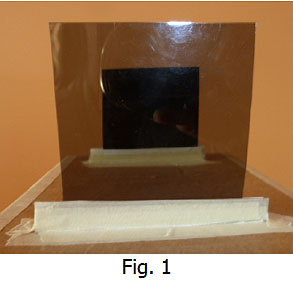
In the other view, the viewer will see through the two filters but only with half the light's original intensity (Fig. 2).
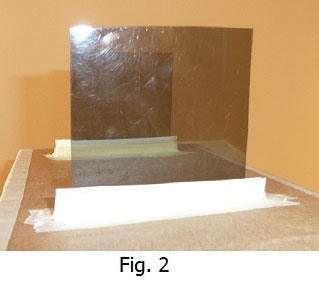
In this case, the filters were aligned and accepted light in the same direction.
- Place the filters into the polarized filter viewer and observe the two views again.
- Place the filters into the viewer so that they are crossed. Take a piece of mica and hold it between the two filters. Look through the viewers at a light or window. Slowly rotate the mica from right to left and in and out. Different colors found in the spectrum should be seen as you move the mica between the filters.
- Repeat with a plastic petri dish, clear plastic cup, the prism or some other object that is transparent. Observe the different colors that can be seen.
Activity 3: Splitting light
- Draw a horizontal line on a piece of paper. Place the calcite crystal over the line. The line should appear to split in two.
- Rotate the crystal over the line in a circular motion. The image should change as the viewer first sees two lines, then one line, and back to two lines. The crystal is refracting the light and depending on how you orient it, it either polarizes the light or keeps it as a solid line.
- Take one of the polarizing filter and place it over the calcite and the double image. Rotate the filter over the double image and again you will see first the top line and then the bottom line.
Activity 4: Refraction of light in water
- Fill a beaker or plastic cup 3/4 full of water. Place a pencil into the cup.

- View the pencil tilted to the side of the cup as well as vertically. When the pencil is tilted to the side of the cup it appears broken at the interface between the air and water. The pencil appears lower in the cup than it actually is. When the pencil is held vertically the portion of the pencil in the water appears wider than it really is again due to the refraction of light when it moves from air to water.
Assessment Plan
Use student pdf to assess student learning
Bibliography
Rio Tinto Hands-on Science Curriculum Team
- Ms. Rae Louie -- Administrator, Principal Beacon Heights Elementary
- Emily Mortensen -- Grant writer, teacher outreach, 2nd grade teacher at Beacon Heights Elementary
- Ruth Li -- Curriculum design, K-6 Science Educator at Indian Hills Elementary
- Deirdre Straight -- Curriculum development, K-6 Science Educator at Beacon Heights Elementary
- Tim Rausch -- Website development, Library Media at Beacon Heights Elementary
Updated: 02/05/2018


 UTAH EDUCATION NETWORK
UTAH EDUCATION NETWORK

 Justin
Justin Braxton
Braxton Dani
Dani Kayla
Kayla Katie
Katie Matthew
Matthew Rob
Rob Val
Val
